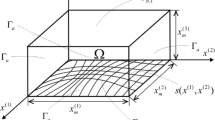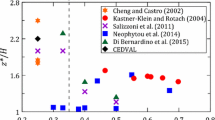Summary
A simple one dimensional wind model, designed for diffusion calculations in flat environments with obstructions, is proposed. It covers the surface layer and up to a maximum height of 500 m with three levels. The lowest level is the internal boundary layer, in which the influence of the immediate environment is manifest. The second is the surface layer in which the wind profile is characterized by the fetch conditions further upstream. The third is the spiral layer, where the wind turns with height. The actual depth of the surface layer is estimated by the model. In both the surface layer and the internal boundary layer, Monin-Obukhov theory is applied. The spiral layer is represented by a classical Ekman-Taylor solution matched at the top of the surface layer. This conceptual model is then tested with data from a meteorological mast at Garching (near Munich, Germany).
Similar content being viewed by others
References
Barker, E. H., Baxter, T. L., 1975: A note on the computations of atmospheric surface layer fluxes for use in numerical modeling.J. Appl. Meteor.,14, 620–622.
Beljaars, A. C. M., 1982: The derivation of fluxes from profiles in perturbed areas.Bound.-Layer Meteor.,24, 35–55.
Beljaars, A. C. M., Holtslag, A. A. M., 1991: Flux parameterization over land surfaces for atmospheric models.J. Appl. Meteor.,30, 327–341.
Berggström, H., 1986: A simplified boundary layer wind model for practical application.J. Climate. Appl. Meteor.,25, 813–824.
Blackadar, A. K., Tennekes, H., 1968: Asymptotic similarity in the planetary boundary layer.J. Atmos. Sci.,25, 1015–1020.
Blom, J., Wartena, L., 1969: The influence of changes in surface roughness on the development of the turbulent boundary layer in the lower layers of the atmosphere.J. Atmos. Sci.,26, 255–265.
Brown, R. A., 1974: Analytical methods in planetary boundarylayer modeling. London: Adam Hilger.
Businger, J. A., Wyngaard, J. C., Izumi, Y., Bradley, E. F., 1971: Flux profile relationships in the atmospheric surface layer.J. Atmos. Sci.,28, 181–189.
Claussen, M., 1991: Estimation of areally-averaged surface fluxes.Bound.-Layer Meteor. 54, 387–410.
Deardorff, J. W., 1974: Three-dimensional numerical study of height and mean structure of a heated planetary boundary layer.Bound.-Layer Meteor.,7, 81–106.
Daewon, W. Byun, 1990: On the analytical solution of fluxprofile relationships for the atmospheric surface layer.J. Appl. Meteor.,29, 652–657.
Daewon, W. Byun, 1991: Determination of similarity functions of the resistance law for the planetary boundary layer using surface layer similarity functions.Bound.-Layer Meteor.,57, 17–48.
Davenport, A. G., 1960: Rational for determining design wind velocities.J. Struct. Div. Amer. Soc. Civ. Eng.,86, 39–68.
Driedonks, A. G. M., 1982: Models and observations of the growth of the atmospheric boundary layer.Bound.-Layer Meteor.,23, 283–306.
Driedonks, A. G. M., Tennekes, H., 1984: Entrainment effects in the well-mixed atmospheric boundary layer.Bound.-Layer Meteor.,30, 75–105.
Elliott, W. P., 1958: The growth of the atmospheric internal boundary layer.Trans. Amer. Geophys. Union,39, 1048–1054.
Fiedler, F., Panofsky, H. A., 1972: The geostrophic drag coefficient and the “effective” roughness length.Quart. J. Roy. Meteor. Soc.,104, 491–502.
Garrett, A. J., 1981: Comparison of observed mixed-layer depths to model estimates using observed temperatures and winds, and MOS forecasts.J. Appl. Meteor.,20, 1277–1283.
Goff, J. A., 1965: Saturation pressure of water on the new Kelvin scale. In: Wexler, A. (ed.),Humidity and Moisture, vol. 3, New York: Reinhold Publishing Corporation, pp. 289–292.
Gryning, S.E., Batchvarova, E., 1990: Simple models of the daytime boundary layer height. Ninth Symposium on Turbulence and Diffusion. American Meteorological Society. April 30–May 3, 1990, Roskilde, Denmark, pp. 379–382.
Haltiner, G. J., Martin, F. L., 1957:Dynamical and Physical Meteorology. New York: McGraw-Hill.
Iribane, J. V., Godson, W. L., 1973:Atmospheric Thermodynamics. Geophysics and Astrophysics Monographs, vol. 6, Dordrecht: D. Reidel, p.71.
Irwin, J. S., Binkowski, F. S., 1981: Estimation of the Monin-Obukhov scaling length using on-site instrumentation.Atmos. Environ.,15, 1091–1094.
Jordan-Engeln, G., Reutter, F., 1976:Formelsammlung zur Numerischen Mathematik mit Fortran IV Programmen. B-I.-Hochschultaschenbücher, Band 106.
Lösslein, H., 1979: Das bodennahe Windfeld bei Starkwind und Sturm im Hinblick auf Bauwerksbelastungen. Diplomarbeit für Meteorologie, Ludwig-Maximilians-Universität München.
Mahrt, L., 1981: Modelling the depth of the stable boundary layer.Bound.-Layer Meteor.,21, 3–19.
Nieuwstadt, F. T. M., 1984: Some aspects of the turbulent stable boundary layer.Bound.-Layer Meteor.,30, 31–55.
Panofsky, H. A., Dutton, J. A., 1984:Atmospheric Turbulence. Models and methods for engineering applications. New York: John Wiley & Sons.
Panofsky, H., Townsend, A. A., 1964: Changes of terrain roughness and wind profile.Quart. J. Roy. Meteor. Soc.,90, 147–155.
Paulson, C. A., 1970: The mathematical representation of wind speed and temperature profiles in the unstable atmospheric surface layer.J. Appl. Meteor.,9, 857–861.
Plate, E. J., 1971: Aerodynamic characteristics of atmospheric boundary layers. AEC critical review series, U.S. Atomic Energy Commission.
Press, W. H., Flannery, B. P., Teukolsky, S. A., Vetterling, W. T., 1990: Numerical recipes in C. Cambridge: Cambridge University Press, pp. 518–528.
Rao, K. S., Wyngaard, J. C., Coté, O. R., 1974: The structure of the two dimensional internal boundary layer over a sudden change in surface roughness.J. Atmos. Sci.,31, 738–746.
Rogers, R. R., Yau, M. K., 1989:A Short Course in Cloud Physics. Oxford UK: Pergamon, pp. 16–17.
Shir, C. C., 1972: A numerical computation of air flow over a sudden change in surface roughness change.J. Atmos. Sci.,29, 304–310.
Smeda, M. S., 1979: Incorporation of planetary boundary-layer processes into numerical forecasting models.Bound.-Layer Meteor.,16, 115–129.
Stull, R. B., 1988:An Introduction to Boundary Layer Meteorology. Dordrecht, Holla: Kluwer Academic Publishers, pp. 596–613.
Taylor, G. I., 1915: The eddy motion in the atmosphere. Phil. Trans. Roy. Soc., A, 215 (Scientific papers 2, I).
Townsend, A. A., 1965: The response of a turbulent boundary layer to abrupt changes in surface conditions.J. Fluid. Mech.,22, 799–822.
Van Ulden, A., 1978: Simple estimates for vertical diffusion from sources near the ground.Atmos. Environ.,12, 2125–2129.
Van Ulden, A. P., Holtslag, A. A. M., 1985: Estimation of atmospheric boundary layer parameters for diffusion applications.J. Climate Appl. Meteor.,24, 1196–1207.
Van Wijk, A. J. M., Beljaars, A. C. M., Holtslag, A. A. M., Turkenburg, W. C., 1990: Diabatic wind speed profiles in coastal regions: Comparison of an internal boundary layer model with observations.Bound.-Layer. Meteor.,51, 49–75.
Wieringa, J., 1976: An objective exposure correction method for average wind speeds measured at a sheltered location.Quart. J. Roy. Meteor. Soc.,102, 241–253.
Wieringa, J., 1981: Estimation of mesoscale and local-scale roughness for atmospheric transport modeling. 11th Int. Tech. Meeting on Air Pollution Modeling and its Application. New York and London: Plenum. pp. 279–295.
Wood, N., Mason, P. J., 1992: The influence of static stability on the effective roughness length for momentum and temperatureQuart. J. Roy Meteor. Soc.,117, 1025–1056.
Zilitinkevich, S. S., 1972: On the determination of the height of the Ekman boundary layer.Bound.-Layer Meteor.,3, 141–145.
Zoumakis, N. M., Kelessis, A. G., 1991: The dependence of the bulk Richardson number on stability in the surface layer.Bound.-Layer Meteor.,57, 407–414.
Author information
Authors and Affiliations
Additional information
With 11 Figures
Rights and permissions
About this article
Cite this article
Ulrich, W.C. A one dimensional wind model for diffusion calculations. Meteorl. Atmos. Phys. 52, 69–89 (1993). https://doi.org/10.1007/BF01025754
Received:
Revised:
Issue Date:
DOI: https://doi.org/10.1007/BF01025754




